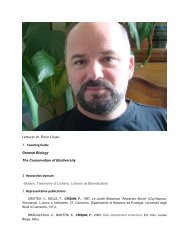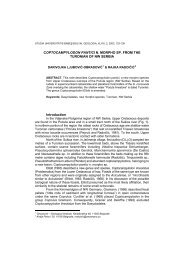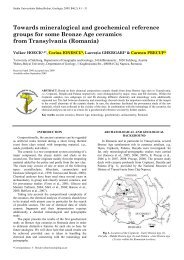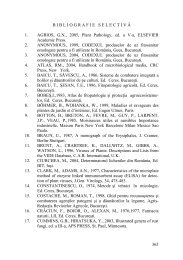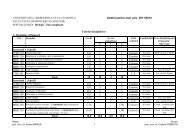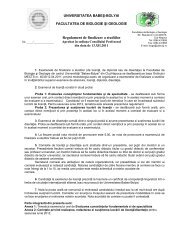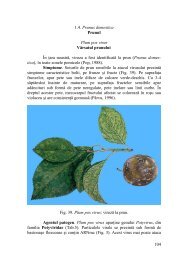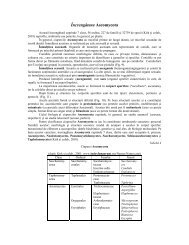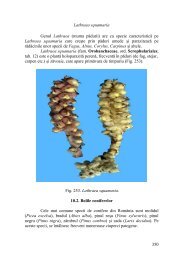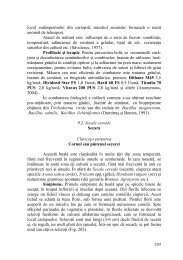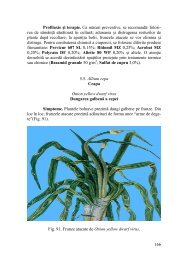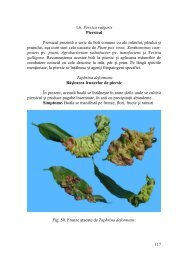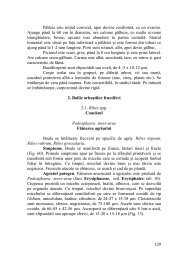Weltrichia givulescui POPA
Weltrichia givulescui POPA
Weltrichia givulescui POPA
Create successful ePaper yourself
Turn your PDF publications into a flip-book with our unique Google optimized e-Paper software.
STUDIA UNIVERSITATIS BABEŞ-BOLYAI, GEOLOGIA, XLVI, 2, 2001, 69-76<br />
ASPECTS OF ROMANIAN EARLY JURASSIC PALAEOBOTANY<br />
AND PALYNOLOGY.<br />
PART IV. A NEW SPECIES OF WELTRICHIA FROM ANINA<br />
MIHAI E. <strong>POPA</strong> 1<br />
ABSTRACT. A new species of bennettite genus <strong>Weltrichia</strong> BRAUN,<br />
<strong>Weltrichia</strong> <strong>givulescui</strong> n.sp., is defined, described and discussed. Its age is<br />
Sinemurian and it was recorded associated with Zamites aninaensis foliage<br />
from Anina, South Carpathians, Resita Basin, where these species are<br />
confined to the upper sandstone sequences of the Valea Tereziei Member,<br />
Steierdorf Formation, between the Coal seams no. 6 and 8.<br />
Keywords: <strong>Weltrichia</strong> <strong>givulescui</strong>, Cycadeoidales, male reproductive structure,<br />
Sinemurian, Anina, South Carpathians, Reşiţa Basin, Romania.<br />
INTRODUCTION<br />
Lower Jurassic deposits of Romania yield a rich land flora, well preserved<br />
and diverse (Popa, 1998, 2000a). One of the most important Liassic plant locality<br />
(LPL) of Romania, a fossile-Lagerstatte locality is Anina (Popa, 1997), formerly known<br />
as Steierdorf, which belongs to the Getic Nappe, Reşiţa Basin respectively. In<br />
Anina occurs a palaeobotanical reserve confined to the southern area of the Ponor<br />
Quarry, known as the Ponor SSSI (Site of Special Scientific Interest). The Lower<br />
Jurassic deposits are included to the Steierdorf Formation (Bucur, 1991), with three<br />
members, the Dealul Budinic Member (Hettangian), a basal, coarse sequence, the<br />
Valea Mereziei Member, an unit including fine sandstones, clays, coal seams, very<br />
rich in plant fossils (Hettangian-Sinemurian) and the Uteris Member (Pliensbachian-<br />
Toarcian), represented by black bituminous shales. Details of the litho- and<br />
phytostratigraphy of the Steierdorf Formation are discussed in detail in Popa<br />
(2000a, b).<br />
The Valea Tereziei Member includes eight coal seams and a refractory<br />
clay bed, where the Hettangian-Sinemurian boundary is recorded (Popa, 2000a,<br />
b). Also, at the Hettangian-Sinemurian boundary is recorded a floral change, where<br />
two separate assemblages are now known to follow one after another. The first,<br />
Hettangian assemblage is marked by the Dipteridaceous fern Thaumatopteris<br />
brauniana and the second, Sinemurian assemblage, is marked by the boom of the<br />
Cycadalean species Nilssonia cf. orientalis. Details of the assemblages and their<br />
definitions are given in Popa (2000a, b). The new species of <strong>Weltrichia</strong> described<br />
in this paper is recorded from the Sinemurian deposits of the Valea Tereziei<br />
Member, from sequences overlying the 6 th Coal seam from Anina.<br />
1 University of Bucharest, Faculty of Geology and Geophysics, Laboratory of Palaeontology,<br />
1, N. Balcescu Ave., 70111, Bucharest, Romania. E-mail: mihaip@geo.edu.ro,<br />
mihaip@math.math.unibuc.ro.
70<br />
MIHAI E. <strong>POPA</strong><br />
SYSTEMATICS<br />
Bennettite male reproductive structures were previously described in<br />
Romania from Lower Jurassic deposits of the South Carpathians and from Middle<br />
Jurassic deposits of Central Dobrogea, south-eastern Romania, together with a<br />
wide variety of foliage types. From the South Carpathians, these reproductive<br />
structures were described mainly from the Reşiţa Basin, the first author to approach<br />
this kind of cycadeoid organs being Krasser (1915, 1922). Krasser (1915) described<br />
“male Williamsonias” from Anina, as Williamsonia banatica and W. alfredi, but<br />
these species belong to the genus <strong>Weltrichia</strong> BRAUN, Williamsonia being a<br />
denomination for female reproductive structures. Langer (1947) described and<br />
figured a “neue <strong>Weltrichia</strong>-Blute” which is actually a <strong>Weltrichia</strong> banatica (Popa, 2000a).<br />
Givulescu (1990) also described two new bennettite reproductive structures from<br />
Anina, including this new taxon. Popa (1998) as well cited <strong>Weltrichia</strong> species<br />
collected from Anina, and described them in detail, together with a Williamsonia<br />
species (Popa, 2000a).<br />
Genus <strong>Weltrichia</strong> was defined by Braun (1849) for bennettite male<br />
reproductive structures but this combination was not used widely by later authors<br />
who preferred to use the term “male Williamsonia”. Nathorst (1909) and Harris<br />
(1969) showed that the denomination of <strong>Weltrichia</strong> should be used instead of that<br />
of “male Williamsonia”.<br />
Class CYCADOPSIDA<br />
Order CYCADEOIDALES<br />
Genus <strong>Weltrichia</strong> BRAUN emend. HARRIS 1969<br />
<strong>Weltrichia</strong> <strong>givulescui</strong> <strong>POPA</strong> n.sp.<br />
Text-figs. 1-4, Pl. I, Figs. 1-3<br />
1969 Williamsonia sp. HUMML, p. 349, Pl. VII, Fig. 15.<br />
1990 <strong>Weltrichia</strong> sp. (?n.sp.) GIVULESCU, p. 2. Pl. 1, Fig. 1, Pl. 2, Fig. 1, 2.<br />
Holotype: fragment 1 from sample P113/C1/30A.<br />
Paratypes: fragment 1 from sample P113/C1/30B and fragment 1 from sample UEB1.<br />
Repository: University of Bucharest, Faculty of Geology and Geophysics, Laboratory<br />
of Palaeontology, in the Popa Palaeobotanical collection.<br />
Type locality: Anina, Caraş-Severin County, Romania.<br />
Stratigraphic horizon: Steierdorf Formation, within the upper, Sinemurian sequence<br />
of the Valea Tereziei Member, mainly within the roofs of the Coal seams nos. 6 and 7.<br />
Etymology: <strong>Weltrichia</strong> <strong>givulescui</strong>, in honor of Professor Dr. Razvan Givulescu,<br />
Corresponding member of the Romanian Academy, as a homage of his brilliant<br />
contributions in the fields of Palaeobotany and Geology, celebrating his 80 th anniversary.
ASPECTS OF ROMANIAN EARLY JURASSIC PALAEOBOTANY AND PALYNOLOGY<br />
Diagnosis<br />
Bennettitalean male reproductive structure with 16 radial microsporophylls (rays)<br />
and a central cup, deeply depressed. The sporophylls have a longitudinal rib on<br />
abaxial and adaxial sides, entire margins, acute apices, they are fibrous and thick,<br />
and each of them is continued centripetally with an appendage that overlaps the<br />
adaxial, inner surface of the central cup. The central cup is covered adaxially by<br />
small pustules, possibly attractant bodies.<br />
Description<br />
Male, reproductive, cup shaped structures with radially disposed, flattened and<br />
fibrous microsporophylls (rays) having a longitudinal, an adaxial and an abaxial rib.<br />
This is why the sporophylls appear to be rhombic in cross section. Substance of<br />
sporophyll lamina very thick. Sporophylls are usually 16 per whorl and they are<br />
adnate in the center of the cup, where the structure is strongly depressed (Pl. I,<br />
Figs. 1, 3). They are inserted radially to the cup, sometimes slightly overlapping to<br />
their bases, although they are always attached in the same plane. Apices of<br />
sporophylls are acute. The external diameter is 80-90 mm, the central, adnate<br />
area’s diameter is 30-40 mm, the length of the free part of sporophylls is 40-50 mm<br />
and their width is 7-10 mm. The external surface of the cup and sporophylls is<br />
smooth, while the internal surface of the cup is slightly granulated, indicating the<br />
occurrence of possible attractant bodies (Text-figs. 2, 4, Pl. I, Fig. 3). Each sporophyll<br />
is continued towards the centre of the cup by a short, free, centripetal appendage<br />
(sterile inner scales), overlapping the inner surface (Text-figs. 1, 3, 4, Pl. I, Fig. 1).<br />
Each appendage is 2-3 mm wide and 7-10 mm long. The adaxial surface of the<br />
sporophylls is rather smooth, without preserving polliniferous sacs or even their<br />
clear insertion. No cuticles or in situ pollen were extracted.<br />
Discussion<br />
In the depressed area of the structure, no indication of any ovulate cone exists, so no<br />
evidence for a possible Williamsonia exists at all. The recently collected material (in<br />
1994, 1995, 1997) from Anina, shows undoubtedly the same species, a clear <strong>Weltrichia</strong><br />
taxon. Harris (1969) showed the validity of <strong>Weltrichia</strong>, instead of “male Williamsonia”,<br />
after a long period of time when the last denomination was largely used.<br />
W. <strong>givulescui</strong> was described by Humml (1969) from Anina as Williamsonia<br />
sp., on material collected from the roof of the Coal seam no. 7, with the same<br />
phytostratigraphic position as the material described here, his data matching again<br />
with the data presented here. His description is accurate but incomplete, his material<br />
being not so well preserved.<br />
This species was previously described also by Răzvan Givulescu (1990)<br />
as <strong>Weltrichia</strong> sp. (?n.sp.), also from Anina locality. He intuited that this is probably<br />
a new species but he did not name it consequently. Actually, his material stored<br />
within the Laboratory of Palaeontology, Babeş-Bolyai University of Cluj-Napoca,<br />
lacks any of the centripetal appendages or pollen sacs, making difficult to assess<br />
the material to a new taxon.<br />
The closest <strong>Weltrichia</strong> species is <strong>Weltrichia</strong> setosa NATHORST emend.<br />
HARRIS 1969. This species resembles W. <strong>givulescui</strong> as it is the only <strong>Weltrichia</strong><br />
species that has centipetal appendages, but these appendages are covered by<br />
long hairs, which is not the case of our new species. Also, the number of sporophylls<br />
71
72<br />
MIHAI E. <strong>POPA</strong><br />
and of the centripetal appendages is far higher than in W. <strong>givulescui</strong>, in W. setosa<br />
each sporophyll tending to have two appendages. Moreover, W. setosa is<br />
associated with Otozamites beani, although Harris (1969) did not assign it surely to<br />
this foliage.<br />
Similarities are shared with <strong>Weltrichia</strong> alfredi KRASSER emend. HARRIS<br />
1969, especially in sporophylls ornamentation, but W. alfredi has less sporophylls<br />
per cup and no attractant bodies inside the central area. W. alfredi is always<br />
associated with Ptilophyllum maculatum foliage and probably it is the reproductive<br />
structure of the plant bearing these leaves.<br />
Another similar reproductive structure that was also described from Anina<br />
and with the same stratigraphic range is <strong>Weltrichia</strong> banatica KRASSER emend.<br />
GIVULESCU 1990. But this species has different shape of sporophylls, and their<br />
number is much higher (21-22). W. banatica is intimately associated with Zamites<br />
schmiedelii foliage and probably it belongs to this species.<br />
The invariable occurrence of W. <strong>givulescui</strong> especially with Zamites aninaensis,<br />
but also with Z. schmiedelii and Z. andraeanus foliage suggests that this structure<br />
belongs to one of these plants, most probably to Z. aninaensis (Pl. I, Fig. 4).<br />
Interesting to note is the role of the centripetal appendages over the central<br />
cup. There is no doubt that <strong>Weltrichia</strong> type structures, as all the other cycadeoid<br />
reproductive structures evolved in intimate connection with insect behavior, and<br />
that a strong coevolution existed between the bennettites and insects. This<br />
coevolution finally had as an effect the emergence of angiosperms (at least part of<br />
them as they are a polyphyletic group) during the Late Jurassic times or even<br />
earlier. In <strong>Weltrichia</strong> <strong>givulescui</strong>, the role of the centripetal appendages might have<br />
been that of increasing the contact surface with the insects or that of<br />
supplementary protection of attractants occurring inside the cup. Trapping insects<br />
temporary or definitively inside the cup may have also been an aim for these<br />
centripetal appendages but it looks more improbable than the other roles.<br />
Preservation<br />
The material is compressed, with the lamina of the microsporophylls often well<br />
preserved. The preservation is rather good, with structures preserved transversally<br />
(Pl. I, Figs.1, 3) or longitudinally (Pl. I, Fig. 2), in spite of polliniferous sacs lacking.<br />
Occurrence and phytostratigraphy<br />
The stratigraphic position of W. <strong>givulescui</strong> is always above the Coal seam No. 5, in<br />
all Anina coalfields. Usually, it can be found within the roofs of the 6 th or 7 th Coal<br />
seams in Anina area, especially for the Northern Coalfields (Anina, Zona Nouă and<br />
Brădet Coalfields). It is a typical Sinemurian taxon and the reproductive structure of<br />
a Sinemurian coal generator.<br />
Conclusions<br />
<strong>Weltrichia</strong> <strong>givulescui</strong> is a new species of male bennettite reproductive structure<br />
from Anina, Sinemurian in age, intimately associated with Zamites aninaensis<br />
foliage and it is probably the reproductive structure of the plant that was bearing<br />
this foliage.
ASPECTS OF ROMANIAN EARLY JURASSIC PALAEOBOTANY AND PALYNOLOGY<br />
Text-fig. 1. <strong>Weltrichia</strong> <strong>givulescui</strong> n.sp., holotype, P113/C1/30A/Fr.1, preserved transversally. Arrows<br />
indicate the presence of appendages. Scale bar: 1 cm.<br />
Text-fig. 2. W. <strong>givulescui</strong> n.sp., paratype, UEB1/Fr.1, preserved transversally. Scale bar: 1 cm.<br />
73
74<br />
MIHAI E. <strong>POPA</strong><br />
Text-fig. 3. Reconstruction of a ripen W. <strong>givulescui</strong> n.sp., with the insertion points of the polliniferous<br />
sacs not figured as they could not be found due to preservation.<br />
Text-fig. 4. Axial section through the central cup of W. <strong>givulescui</strong> n.sp., showing the internal bodies,<br />
appendages and sporophylls. Arrows indicate the possible position of the polliniferous<br />
sacs.
ASPECTS OF ROMANIAN EARLY JURASSIC PALAEOBOTANY AND PALYNOLOGY<br />
Acknowledgements<br />
I wish to thank to Dr. Valentin Popescu (Ecological University, Bucharest), Dr. Iustinian<br />
Petrescu and Dr. Ioan I. Bucur (Babeş-Bolyai University, Cluj-Napoca) for their kind<br />
help. This paper is part of a larger work presented by the author in Quinhuangdao,<br />
China, to the VI-th IOP Conference, in August 2000. Financial support was provided<br />
by the Romanian Academy research Grant no. 5003/1999.<br />
REFERENCES<br />
Braun, F. (1849), <strong>Weltrichia</strong>, eine neue Gattung fossiler Rhyzantheen, Flora, 32:705-712.<br />
Bucur, I.I. (1991), Proposition pour une nomeclature lithostratigraphique formelle des depots<br />
paleozoiques et mesozoiques de la zone de Resita-Moldova Noua (Carpathes<br />
meridionales, Roumanie), Studia Univ. Babeş-Bolyai, Geologie, XXXVI/2: 3-14.<br />
Krasser, F. (1915), Mannlische Williamsonien aus dem Sandsteinschiefer des unteren Lias von<br />
Steierdorf im Banat. Denkschrisften der mathem.-naturw. Klasse, 93(107): 1-18.<br />
Krasser, F. (1922) Zur Kenntnis einiger fossiler Floren des unteren Lias den<br />
Sukzessionstaaten von Ostereich-Ungarn. Sitzungsberichte d. mathem.-naturw. Kl.,<br />
1: 345-373.<br />
Langer, J. (1947), Uber einige Stucke der Liasflora von Steierdorf und der Keuperflora von<br />
Lunz. Jahrbuch der Geologischen Bundesanstalt, XC(1-2): 22-33.<br />
Harris, T.M. (1969), The Yorkshire Jurassic Flora. Part 3: Bennettitales, 3, London, 186 pp.<br />
Givulescu, R. (1990), Zwei neue Bennettitenblutten aus dem Unteren Lias von Anina (Banat,<br />
Rumanien). Documenta Naturae, 59(2): 1-7.<br />
Humml, H. (1969) Contributii la flora fosila a Liasicului inferior de la Steierdorf-Anina. Stud.<br />
Cerc. Geol. Geofiz. Geogr. (Geol.), 14(2): 385-404.<br />
Nathorst, A. (1909), Paleobotanische Mitteilungen, no. 8. Uber Williamsonia, Wielandia,<br />
Cycadocephalus und <strong>Weltrichia</strong>. Kongl. Svenska Vetenskaps Akademiens<br />
Handlingar, 45(4).<br />
Popa, M.E. (1997), Corystospermal pteridosperms in the Liassic continental deposits of<br />
Romania. Acta Palaeontologica Romaniae(1): 81-87.<br />
Popa, M.E. (1998), The Liassic continental flora of Romania: Systematics, Stratigraphy and<br />
Paleoecology. Acta Horti Botanici Bucurestiensis, (1997-1998): 177-184.<br />
Popa, M.E. (2000a), Early Jurassic land flora of the Getic Nappe, University of Bucharest,<br />
Bucharest, PhD thesis, 258 pp.<br />
Popa, M.E. (2000b), Aspects of Romanian Early Jurassic Palaeobotany and Palynology. Part III.<br />
Phytostratigraphy of the Getic Nappe. Acta Palaeontologica Romaniae, 2: 377-386.<br />
Plate I<br />
PLATE CAPTIONS<br />
Fig. 1. <strong>Weltrichia</strong> <strong>givulescui</strong> n.sp., holotype, P113/C1/30A/Fr.1, preserved transversally.<br />
Fig. 2. W. <strong>givulescui</strong> n.sp., paratype, P113/C1/30B/Fr.1, preserved longitudinally.<br />
Fig. 3. W. <strong>givulescui</strong> n.sp., paratype, UEB1/Fr.1, preserved transversally.<br />
Fig. 4. Zamites aninaensis, P113/C1/48/Fr.1. All scale bars: 1cm.<br />
75
76<br />
MIHAI E. <strong>POPA</strong>



